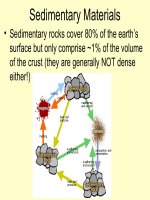Lecture 24 mass wasting
Bạn đang xem bản rút gọn của tài liệu. Xem và tải ngay bản đầy đủ của tài liệu tại đây (7.69 MB, 76 trang )
Chapter 16
Landslides & Mass Wasting
Earth’s Surface is shaped by external processes…
Earth’s Surface is shaped by external processes…
In sculpting the Earth’s surface,
the two most important agents
of erosion are :
1) Mass wasting
2) Running water
There are a wide variety of manifestations
of the downslope movement of materials
by gravity, some faster and some slower.
pp.490-491
original artwork by Gary Hincks
All of these processes have destructive effects…
Mass Wasting: Downslope,
mass movement of Earth materials
Driven by: The pervasive background force of
…GRAVITY…
Contributing factors:
Saturation of sediments by water
Water fills pore spaces between sediment grains,
reduces internal resistance, adds weight.
Over-steepened slopes
Slopes become unstable once they reach the angle of repose =
The steepest angle a slope can attain without slumping.
Removal of vegetation
Plants add slope stability by
protection against erosion.
Earthquakes
Strong ground vibrations.
Stability against
gravity depends
on the strength
of a material,
which can be
represented
by its angle of
repose…
In sediments, this
angle depends on
grain and sorting.
Fig. 16.20 c
W. W. Norton
In sediments, the angle of repose depends on
grain size and sorting of materials…
Mass Wasting
Types of materials:
Soil/regolith -or- Rock/bedrock
Types of movement:
Rock Falls - Free-fall of material
Rock/Debris Slides - Coherent slabs
slide along fracture surfaces
Mudflows - Soil and rock mixes with water
and becomes fluidized.
Earth or Debris Flows - Materials
move as a viscous mass.
Rates
movement:
Fastest
- Rock of
falls
& avalanches.
Avalanches “float” on
entrapped air.
Slowest - Creep (cm/year).
Talus slopes
Types of mass wasting processes arrayed
by typical velocity of movement….
Fig. 16.12
W. W. Norton
Rock Fall/Debris Fall
Fig. 16.12
W. W. Norton
MASS
WASTING
Rock/Debris Falls
Blocks of bedrock break free, and fall from a
steep cliff face.
Contributing factors:
- Steep slopes.
- Rocks loosened along joint fractures…
…by expansion of water on freezing,
…by thermal expansion/contraction,
…by biological activity (e.g. root growth)
- Ground shaking during earthquakes.
Fig. 16.14
Stephen Marshak
Fig. 16.15
W. W. Norton
Rock Falls…
Fig. 16.22
W. W. Norton
Steps to mediate…
Fig. 16.27 hi
W. W. Norton
Mediation…
Fig. 16.27 g
W. W. Norton
Mediation…
Fig. 16.27 e
W. W. Norton
Talus
Rock falls and avalanches produce talus slopes…
Fig. 16.08
Stephen Marshak
Mother of
all rock falls!
Mediation by terracing
Avalanches
Fig. 16.12
W. W. Norton
Before
After
Peruvian Valley Rock Avalanche, May 1970









